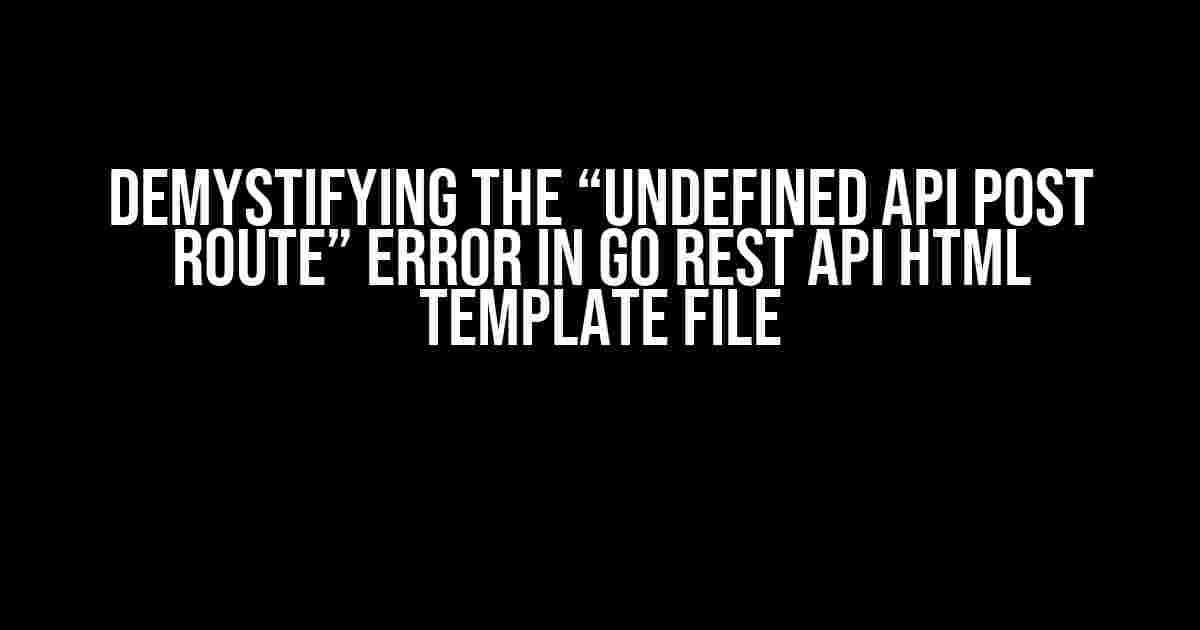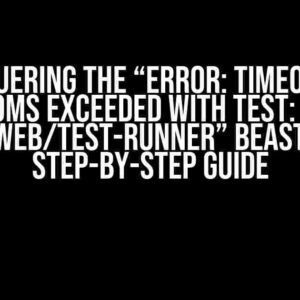Are you scratching your head, wondering why your Go REST API is throwing an “Undefined API POST Route” error when trying to interact with your HTML template file? Worry no more, friend! This comprehensive guide will walk you through the troubleshooting process, providing clear explanations and step-by-step instructions to get your API up and running in no time.
What is an API POST Route?
An API POST route is a critical component of any RESTful API. It’s the endpoint that allows clients to send data to your server, which can then be processed, stored, or manipulated accordingly. In the context of a Go REST API, a POST route is typically defined using the `http.HandleFunc` function, which maps a specific URL path to a handler function.
package main
import (
"fmt"
"net/http"
)
func main() {
http.HandleFunc("/users", createUserHandler)
http.ListenAndServe(":8080", nil)
}
func createUserHandler(w http.ResponseWriter, r *http.Request) {
// Handle POST request logic here
}What Causes the “Undefined API POST Route” Error?
So, why does this error occur in the first place? There are a few common reasons:
- Missing or Incorrect API Route Definition: If the API route is not defined or is defined incorrectly, the server won’t know how to handle the incoming request, resulting in the “Undefined API POST Route” error.
- Typo in Route Path or Method: A small typo in the route path or method can lead to this error. Make sure to double-check your code for any mistakes.
- Incorrect Request Method: If the client sends a request with an incorrect method (e.g., sending a GET request to a POST route), the server will throw an error.
- Mismatched Content-Type Header: If the client sends a request with a content-type header that doesn’t match the expected type (e.g., sending JSON data with a `text/plain` header), the server may not be able to process the request correctly.
Step-by-Step Troubleshooting Guide
Now that we’ve covered the common causes of the “Undefined API POST Route” error, let’s go through a step-by-step process to troubleshoot and fix the issue:
- Check the API Route Definition: Verify that the API route is defined correctly in your Go code. Ensure that the route path and method match the expected values.
- Verify the Request Method and Path: Use a tool like
cURLor a REST client like Postman to send a request to the API endpoint. Check the request method and path to ensure they match the expected values. - Inspect the Request Headers and Body: Use the same tool to inspect the request headers and body. Check that the content-type header matches the expected type (e.g., `application/json` for JSON data) and that the request body is formatted correctly.
- Check the Server Logs: Review the server logs to see if there are any error messages or warnings that can provide clues about the issue.
- Test the API Route with a Minimal Example: Create a minimal example of the API route and test it independently to ensure it’s working as expected.
Example: Creating a Minimal API Route in Go
Let’s create a simple API route in Go that handles a POST request:
package main
import (
"encoding/json"
"fmt"
"net/http"
)
type User struct {
Name string `json:"name"`
Email string `json:"email"`
}
func main() {
http.HandleFunc("/users", createUserHandler)
http.ListenAndServe(":8080", nil)
}
func createUserHandler(w http.ResponseWriter, r *http.Request) {
if r.Method != http.MethodPost {
http.Error(w, "Invalid request method", http.StatusBadRequest)
return
}
var user User
err := json.NewDecoder(r.Body).Decode(&user)
if err != nil {
http.Error(w, "Invalid request body", http.StatusBadRequest)
return
}
fmt.Println("User created:", user.Name, user.Email)
w.Write([]byte("User created successfully"))
}Best Practices for Defining API Routes in Go
To avoid the “Undefined API POST Route” error and other common pitfalls, follow these best practices when defining API routes in Go:
- Use Consistent Route Naming Conventions: Establish a consistent naming convention for your API routes to avoid confusion.
- Define API Routes with Care: Double-check your API route definitions to ensure they are correct and well-formed.
- Use HTTP Methods Correctly: Use the appropriate HTTP method for each API route (e.g., POST for creating resources, GET for retrieving resources, etc.).
- Validate Request Data: Always validate request data to ensure it meets the expected format and structure.
- Handle Errors Gracefully: Implement proper error handling mechanisms to provide informative error messages and prevent panics.
Conclusion
The “Undefined API POST Route” error can be frustrating, but with the right troubleshooting steps and a clear understanding of API route definitions, you’ll be well-equipped to tackle this issue head-on. By following the best practices outlined in this article, you’ll be able to create robust and reliable API routes in Go that handle requests correctly and efficiently.
| Common Causes of “Undefined API POST Route” Error | Troubleshooting Steps |
|---|---|
| Missing or Incorrect API Route Definition | Check API route definition in Go code, verify route path and method |
| Typo in Route Path or Method | Double-check code for typos, ensure correct route path and method |
| Incorrect Request Method | Verify request method matches expected value (e.g., POST, GET, etc.) |
| Mismatched Content-Type Header | Inspect request headers and body, ensure content-type header matches expected type |
By applying these troubleshooting steps and best practices, you’ll be able to overcome the “Undefined API POST Route” error and create a robust and reliable Go REST API that interacts seamlessly with your HTML template file.
Here are 5 Questions and Answers about “Go REST API HTML Template File: Undefined API POST Route” in a creative voice and tone:
Frequently Asked Questions
Get answers to your burning questions about Go REST API HTML Template File and Undefined API POST Route!
What is the most common reason for an undefined API POST route in Go REST API?
The most common reason for an undefined API POST route in Go REST API is a typo or incorrect route definition in the code. Double-check your route definition and make sure it matches the exact route you’re trying to call.
Can I define multiple routes with the same path but different HTTP methods?
Yes, you can define multiple routes with the same path but different HTTP methods. For example, you can have a GET route and a POST route with the same path, but different handlers. Go’s net/http package allows you to define routes with the same path but different methods.
How do I handle errors in my POST route handler?
You can handle errors in your POST route handler by using the built-in `error` type in Go. You can return an error from your handler function and let the framework handle it, or you can handle the error manually by checking for errors and returning an error response.
Can I use a single route handler for both POST and GET requests?
While it’s technically possible to use a single route handler for both POST and GET requests, it’s not recommended. It’s better to have separate handlers for each request method to keep your code organized and easy to maintain. However, you can use a single handler function and check the request method using the `req.Method` property.
How do I debug an undefined API POST route in Go REST API?
To debug an undefined API POST route in Go REST API, try using a tool like `curl` or `Postman` to send a request to the route and see the response. You can also use Go’s built-in logging package to log the request and response data. Additionally, you can use a debugger like `delve` to step through your code and see where the request is being handled.
I hope this helps!




